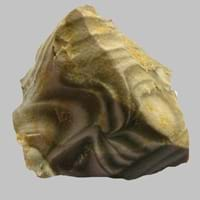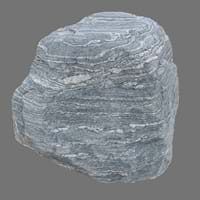Definition
Flint is a hard type of sedimentary rock that produces a small piece of burning material when hit by steel
Migmatite is typically a granitic rock within a metamorphic host rock which is composed of two intermingled but distinguishable components
Origin
Unknown
Southern Alps, France
Discoverer
Unknown
Jakob Sederholm
Etymology
From Old English flint - a type of rock mainly known for high hardness and for giving off sparks when struck
From the Greek word migma which means a mixture
Class
Sedimentary Rocks
Metamorphic Rocks
Sub-Class
Durable Rock, Hard Rock
Durable Rock, Medium Hardness Rock
Group
Not Applicable
Not Applicable
Other Categories
Fine Grained Rock, Opaque Rock
Coarse Grained Rock, Fine Grained Rock, Medium Grained Rock, Opaque Rock
Texture
Banded, Rough
Foliated
Color
Black, Brown, Green, Grey, Red, White
Black, Bluish - Grey, Brown, Brown- Black, Dark Greenish - Grey, Dark Grey to Black
Durability
Durable
Durable
Scratch Resistant
Yes
Yes
Appearance
Glassy or Pearly
Dull, Banded and Foilated
Interior Uses
Decorative Aggregates, Homes, Interior Decoration
Countertops, Flooring, Kitchens
Exterior Uses
As Building Stone, As Facing Stone, Garden Decoration, Office Buildings, Paving Stone
As Building Stone, As Facing Stone
Other Architectural Uses
Curbing
Curbing
Construction Industry
Arrowheads, Cutting Tool, Spear Points
As Dimension Stone, Cement Manufacture, for Road Aggregate, Making natural cement
Medical Industry
Not Yet Used
Not Yet Used
Antiquity Uses
Artifacts
Artifacts
Commercial Uses
Creating Artwork, Gemstone, In fire-starting tools, Manufacture of tools, Metallurgical Flux, Jewelry, To ignite fire, Used in flintlock firearms
Cemetery Markers, Jewelry, Tombstones, Used to manufracture paperweights and bookends
Types
Not Available
Diatexites and Metatexites
Features
Clasts are smooth to touch, Easily splits into thin plates, Has High structural resistance against erosion and climate
Generally rough to touch, Is one of the oldest rock
Archaeological Significance
Monuments
Not Yet Used
Not Yet Used
Famous Monuments
Not Applicable
Not Applicable
Sculpture
Not Yet Used
Not Yet Used
Famous Sculptures
Not Applicable
Not Applicable
Pictographs
Not Used
Used
Petroglyphs
Not Used
Used
Figurines
Not Yet Used
Not Yet Used
Formation
Flint is formed by the decomposition and compaction of various organisms such as sponges and diatoms under the water.
Migmatites form by high temperature regional and thermal metamorphism of protolith rocks where rocks melt partially due to high temperature.
Mineral Content
Silicon
Biotite, Chlorite, Feldspar, Garnet, Graphite, Hornblade, Micas, Muscovite or Illite, Quartz, Quartzite, Silica, Zircon
Compound Content
Silicon Dioxide
Aluminium Oxide, NaCl, CaO, Carbon Dioxide, Iron(III) Oxide, FeO, Potassium Oxide, Magnesium Carbonate, MgO, MnO, Phosphorus Pentoxide, Silicon Dioxide, Titanium Dioxide
Types of Metamorphism
Not Applicable
Burial Metamorphism, Cataclastic Metamorphism, Regional Metamorphism
Types of Weathering
Not Applicable
Biological Weathering, Chemical Weathering, Mechanical Weathering
Types of Erosion
Chemical Erosion, Coastal Erosion, Water Erosion
Chemical Erosion, Glacier Erosion, Water Erosion, Wind Erosion
Grain Size
Very fine-grained
Medium to Fine Coarse Grained
Fracture
Conchoidal
Irregular
Porosity
Highly Porous
Very Less Porous
Luster
Vitreous
Dull to Pearly to Subvitreous
Compressive Strength
Not Available
Cleavage
Non-Existent
Poor
Specific Gravity
2.5-2.8
2.65-2.75
Transparency
Translucent to Opaque
Opaque
Density
2.7-2.71 g/cm3
Not Available
Specific Heat Capacity
Not Available
Resistance
Heat Resistant, Impact Resistant, Pressure Resistant, Wear Resistant
Heat Resistant, Pressure Resistant
Deposits in Eastern Continents
Asia
Azerbaijan, China, Russia
China, India, Iran, Iraq, Kazakhstan, Kyrgyzstan, Mongolia, Russia
Africa
Not Yet Found
Cameroon, Ethiopia, Ghana, Kenya, Madagascar, Morocco, Mozambique, Namibia, Nigeria, Tanzania, Togo
Europe
Austria, Belgium, Cyprus, Denmark, France, Germany, Italy, Malta, Netherlands, Poland, Portugal, Romania, Spain, Sweden, Switzerland, Turkey, Ukraine, United Kingdom
Albania, Austria, Bosnia and Herzegovina, Finland, France, Georgia, Germany, Hungary, Italy, Kosovo, Monaco, Norway, Poland, Romania, Serbia, Slovakia, Slovenia, Sweden, Switzerland, Ukraine, United Kingdom
Others
Not Yet Found
Not Yet Found
Deposits in Western Continents
North America
USA
Canada, Costa Rica, Cuba, Mexico, Panama, USA
South America
Bolivia
Argentina, Bolivia, Brazil, Chile, Colombia, Ecuador, Peru, Venezuela
Deposits in Oceania Continent
Australia
New Zealand, South Australia
New South Wales, New Zealand, Queensland, Victoria
All about Flint and Migmatite Properties
Know all about Flint and Migmatite properties here. All properties of rocks are important as they define the type of rock and its application. Flint belongs to Sedimentary Rocks while Migmatite belongs to Metamorphic Rocks.Texture of Flint is Banded, Rough whereas that of Migmatite is Foliated. Flint appears Glassy or Pearly and Migmatite appears Dull, Banded and Foilated. The luster of Flint is vitreous while that of Migmatite is dull to pearly to subvitreous. Flint is available in black, brown, green, grey, red, white colors whereas Migmatite is available in black, bluish - grey, brown, brown- black, dark greenish - grey, dark grey to black colors. The commercial uses of Flint are creating artwork, gemstone, in fire-starting tools, manufacture of tools, metallurgical flux, jewelry, to ignite fire, used in flintlock firearms and that of Migmatite are cemetery markers, jewelry, tombstones, used to manufracture paperweights and bookends.









